2.1 Personal and Public Identities in China
8 min read•june 18, 2024
Emily Guo
Emily Guo
Personal Identity Evolution in China
我到底是谁?💭我的存在是为了什么?我相信什么?These may be some questions you have been asked or even considered yourself. In so many situations, you are asked to describe yourself. Starting from a young age, you can be asked to describe your interests, hobbies, and personality. When you age, you are expected to respond in more detail and give examples of who you are. Knowing how to express yourself in Chinese is important for AP Chinese. You may be asked to explain details about your personality and other details on how you identify yourself in Chinese.
When talking about the LGBTQ+ community and non-binary individuals, the Chinese language and culture are very restricted. Given this, thousands of years of restrictions are hard to erase, and it is still a work in progress. There are a couple of terms that can be used, although they aren't as commonly known as they should be. 你 (nǐ) can be used for any gender/non-binary as well as 他. Since 她 didn't exist until the New Culture Movement in the 1910s and 1920s, 他/他们 can be used to refer to they/them.
Religion in China
In China, the official Communist Party of China is atheist, however, there are five recognized religions by the party. Any other religion is not accepted, except old and traditional Chinese practices. The five religions are Buddhism, Catholicism, Daoism, Protestantism, and Islam. Religious groups and believers must be registered.
From data obtained by the China Family Panel Studies in 2014, about 73.5% of people are unaffiliated with religion, or practice Chinese folk religion. Since many do not consider Chinese folk religion a "religion", that number may be larger. Roughly 16% of Chinese practice Buddhism, with folk sects and the Taoist Church coming in at number 3 with about 7.5%. Christians make up about 2.5% and Islam fills up the remaining 0.5% as a minority.
The image below was taken inside a Buddhist temple in China.
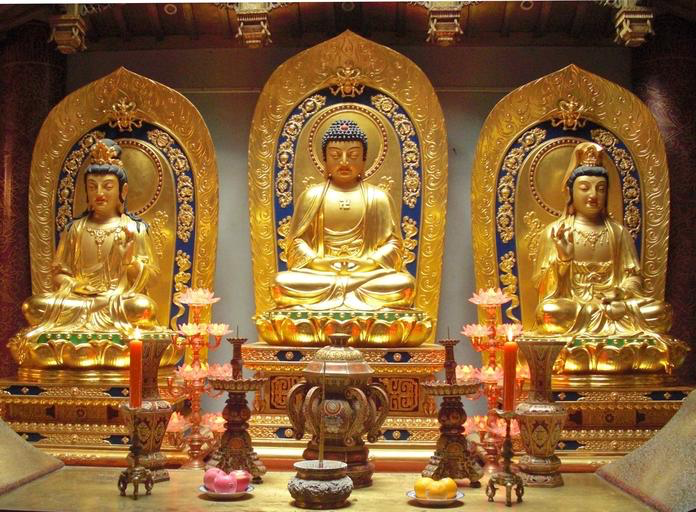
Image Courtesy of Snappy Goat
Education in China
Education is considered vital in China, as many old proverbs in China say that to increase one's social class, they must be educated. One of these proverbs is 玉不琢,不成器 (yù bù zhuó, bù chéng qì), which means that one has to be educated to be useful. Every year, there are about 8 million graduates in Chinese colleges and universities. That number is more than the number of graduates each year from the US and India put together!
The Compulsory Education Law in China states that all children have to finish at least nine years of education, and they are currently pushing for more and more literacy among its citizens. In Beijing, the literacy rate was almost 99% in 2014 and Shanghai had a literacy rate of almost 97%, also in 2014.
What Makes a Chinese Person Chinese?
As mentioned in Unit 1, China has a gigantic population. Not only does it have the largest population, about 1.393 billion, but it is also the third largest country in land size! There are also many immigrant Chinese people spread out throughout the world. This means that there are Chinese people almost everywhere you go! It has the second largest economy, developed through its extensive production speed.
In China, working overtime is very common. There is a limit of 44 hours per week. However, many don't follow this and continue to work tens of hours of overtime each week. A common system used is known as the 996 working hour system. Many jobs in the tech industry have their employees follow this system, working a 9 am to 9 pm job for 6 days a week. This adds up to 72 hours every week. Many argue that this can have dangerous impacts on the health of employees.
Annual, paid leave, is based on how many years someone has been employed. If you have worked less than one year, you have no paid leave. If you have worked 1 to 10 years, you have 5 days of annual leave. If you have worked 10 to 20 years, you have 10 days of leave. And any work over 20 years, you have 15 days of annual leave.
Holidays are required to be paid days. For Chinese employees, these include New Year's Day, Lunar New Year's Day, Qing Ming Festival, Labor Day, Dragon Boat Festival, Mid-Autumn Festival, and National Day.
Personality
For many Chinese people, keeping your word and saving face is very important. Staying generally polite and having the respect of others can be the most important value for some. Modesty is a common trait as well, especially for those who are successful. There is an old proverb in China that suggests the idea of having fame as a bad thing and will bring trouble.
Many Chinese struggle with expressing their feelings, even among their own families. Staying within a group, such as how immigrants tend to form groups with other Chinese immigrants, is a force of habit for many. There are many forums and blogs that connect millions of Chinese immigrants around the world, such as huaren.us for North America.
With communication, many believe in less talking and more thinking. Conversations tend to include many metaphors and dancing around the subject without getting straight to the point. Mental health in China is very stigmatized, as keeping your mouth shut about issues is seen as "strong", while those who seek help are considered "weak".
Related Vocabulary
- 我(wǒ)- I/me/myself
- 年龄(niánlíng)- Age
- 性倾向(xìng qīngxiàng)- Sexual Orientation
- 变性人(biànxìng rén)- Transgender Person
- 非二元性别(Fēi èr yuán xìngbié)- Non-binary Gender
- 异性恋者(yìxìng liàn zhě)- Heterosexual
- 同性恋者(tóngxìngliàn zhě)- Gay/Lesbian Person
- 酷儿(kù er)- Queer
- 宗教(zōngjiào)- Religion
- 无神论者(wúshénlùn zhě)- Atheist
- 佛教(fójiào)- Buddhism
- 天主教(tiānzhǔjiào)- Catholicism
- 道教(dàojiào)- Daoism
- 识字率(shìzì lǜ)- Literacy Rate
- 加班(jiābān)- Overtime
- 996 工作制(996 gōngzuò zhì)- 996 Working Hour System
- 年假(niánjià)- Annual Leave
- 谦虚(qiānxū)- Modesty
- 精神健康(jīngshén jiànkāng)- Mental Health
Language and Cultural Identity in China
Chinese Language
Even though this AP course is labeled as AP Chinese, technically it is Mandarin and Cantonese. Both use the same characters, except that Mandarin usually uses simplified Chinese instead of traditional characters. There are also many other dialects in China. Here is a map of all the relative regions and their dialects:
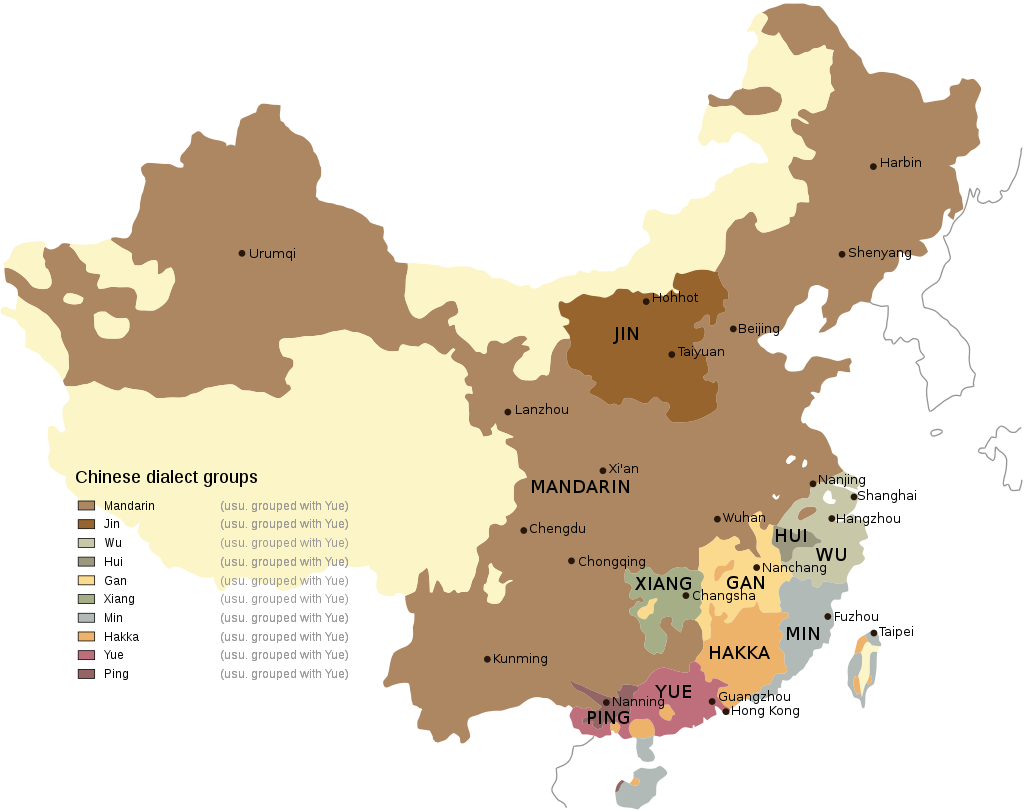
Image Courtesy of Wikipedia
Dialects️ in China are much like how Americans use specific words based on their region. However, pronunciations of things do get more and more different and harder to understand (if you learn basic Mandarin) the farther South you go. It's a lot like an accent! Dialects are known as 方言 (fāngyán).
Mandarin from 北京 (běijīng) is usually taught in many schools aside from the dialect of that specific region. This dialect tends to add a lot of 儿 sounds at the end of words.
Chinese Alphabet

Image Courtesy of Wikimedia Commons
A Chinese alphabet doesn't technically exist, although the 拼音 (Pinyin) system exists. It's used to transcribe through transcription. It was created in the 1950s and uses the Latin alphabet. It uses four tone marks to represent the tones, typically over vowels in a words. 汉语拼音 is the official name, where 汉语 (hànyǔ) quite literally means "the spoken language of the Han people" as that is the largest ethnic group in China.
The complicated aspect is that the pronunciations of the letters are MUCH different than English. Here is a list of the 100 most used Chinese characters and their Pinyin equivalents:
Immigration and Emigration in China
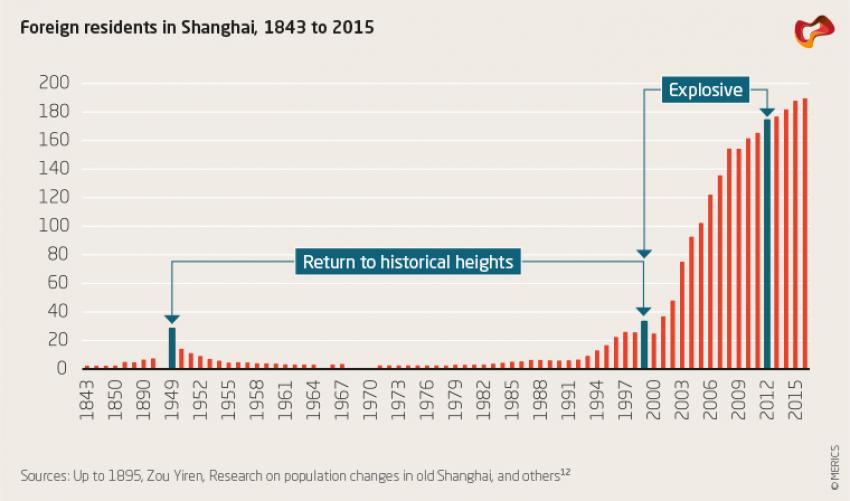
Image Courtesy of Merics
In the past couple of years, the number of people immigrating to China has increased. In 2018, there were 95 million foreigners border crossed China (including those who immigrated). In the same year, the National Immigration Agency (in China) 国家移民管理局 (guójiā yímín guǎnlǐ jú) was established.
Back in 2012, the Exit-Entry Law was passed, which includes information on immigration, naturalization, refugees, etc. Illegal immigration details were added later.
Fun Fact: China became a member of the International Organization for Migration (IOM) in 2016!
After the effects of the One-Child policy, the structure of the population in China changed profoundly. It's estimated that by 2030, there will be 1/4 of China's population to be over 60. The labor force is continuously shrinking, causing a need for more foreign immigration to support the economy. The Chinese government has previously not been willing to seek help by increasing and promoting immigration into China, however, that may need to change.
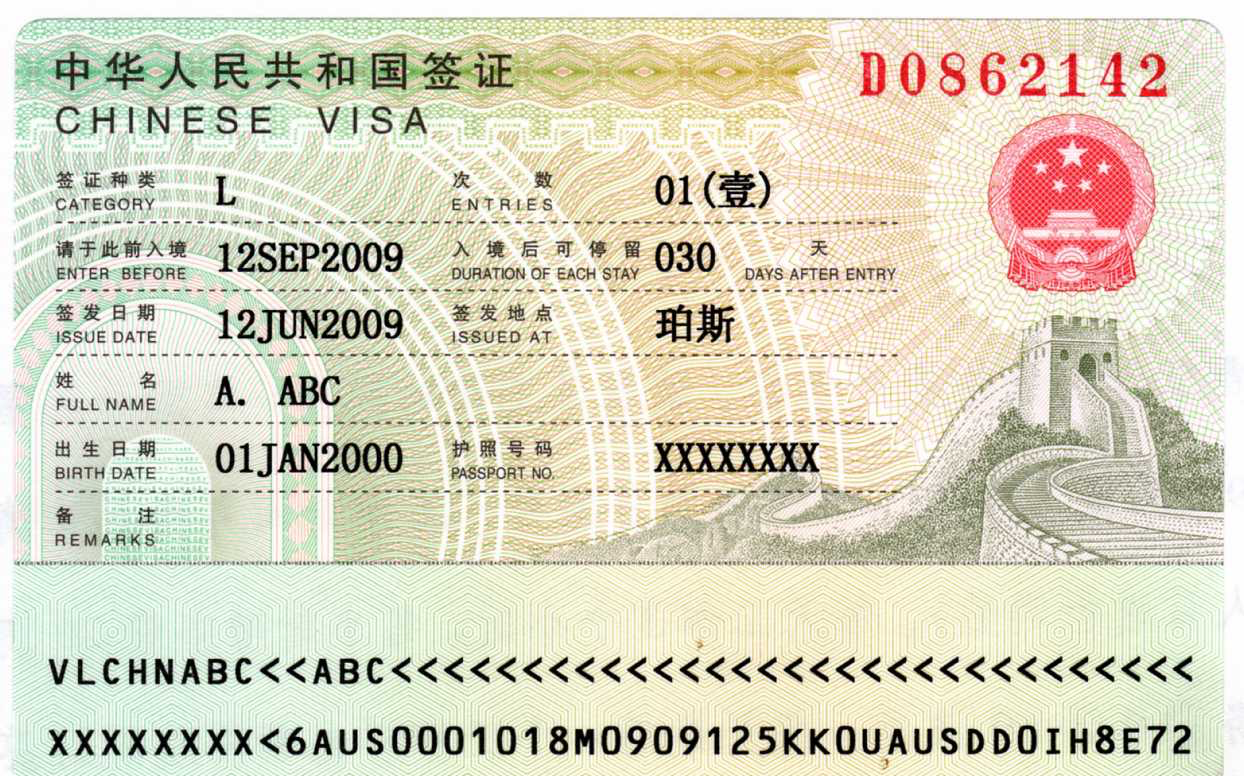
Image Courtesy of Wikimedia Commons
The image above displays the recent growth of foreigners (外国人(wàiguó rén) or 老外(lǎowài)) in Shanghai, China's biggest city, which also holds about a quarter of the foreign population in China. At about the year 2000, there is a clear jump in the number of foreigners in China.
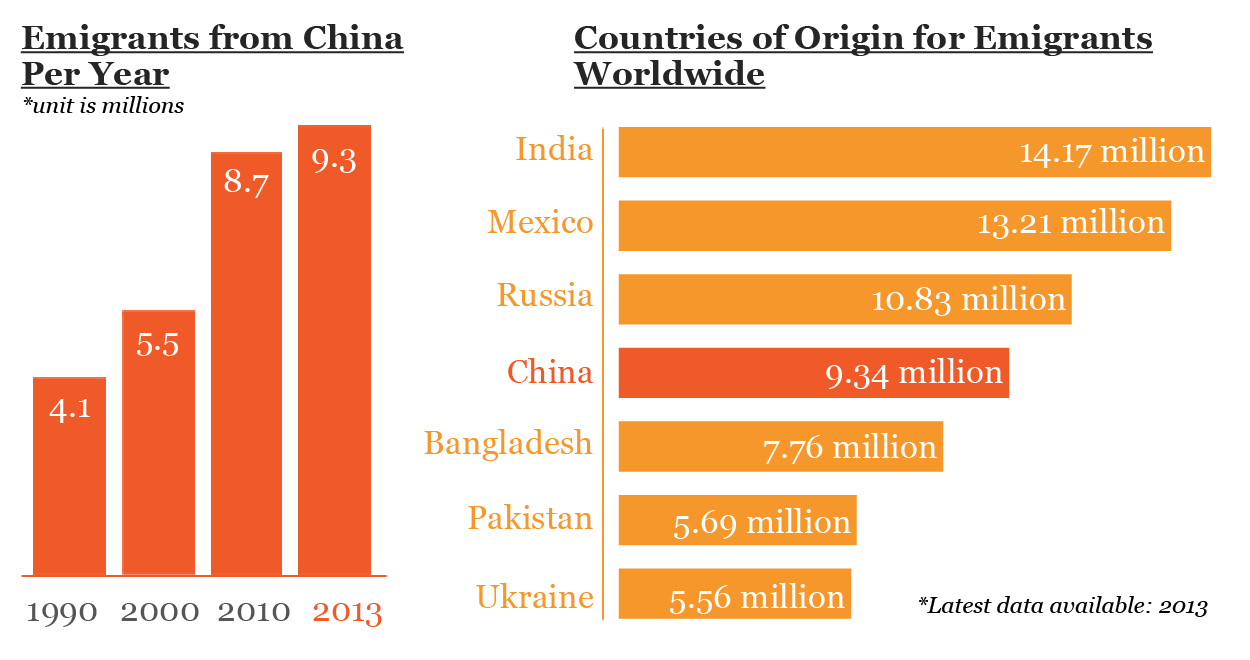
Image Courtesy of China File
Visas (签证(qiānzhèng)) in China fall under very defined categories. You can get a tourist, business, non-commerce, work, study, private, family, crew, or group visa. You are supposed to stay in the defining borders of your visa and not do what is not given by your visa.
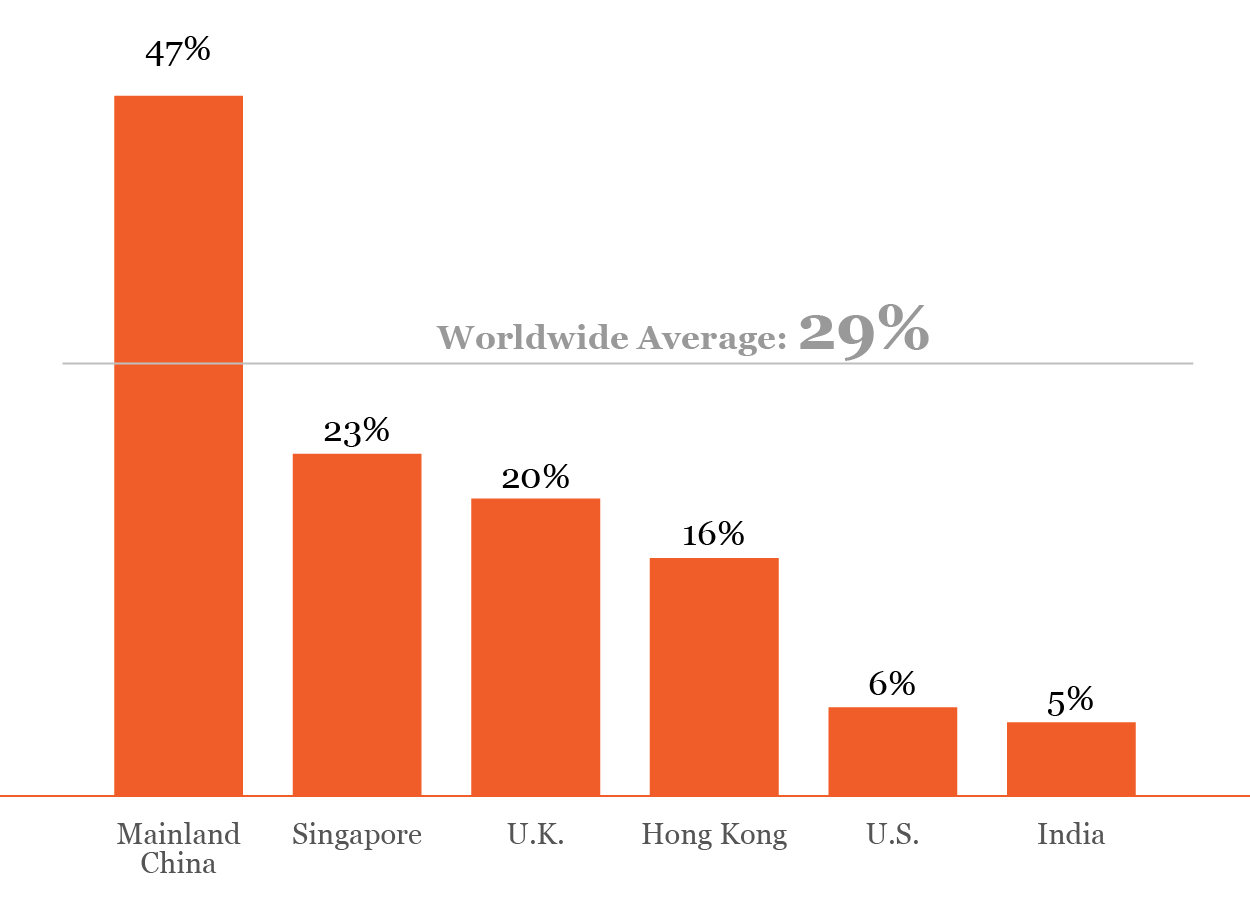
Image Courtesy of China File
China currently has the fourth largest number of emigrants. In 2013, there were 9.34 million people who emigrated from China. More and more of the wealthy Chinese emigrate or plan to emigrate. About 47% of the rich in China plan to emigrate within the next five years based on a survey by Barclays in 2014. The top locations that they do emigrate to are the US and Canada. However, since they are spending and investing much of their wealth out of China, the country's wealth is decreasing.
Diversity in China
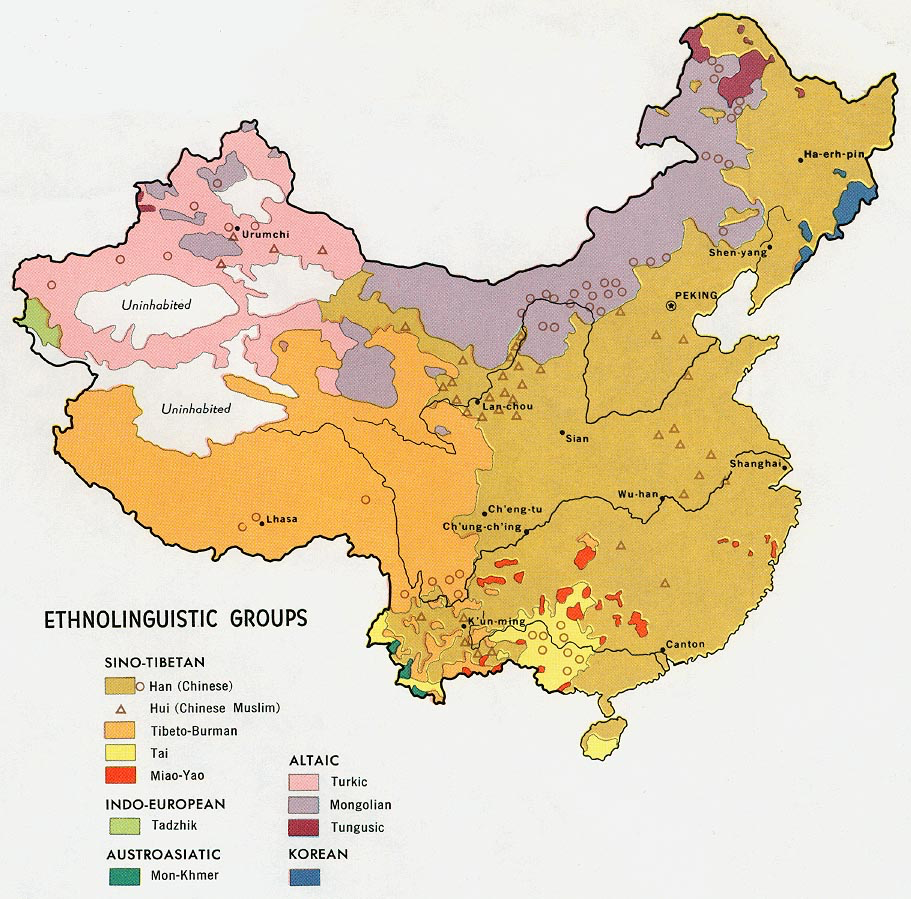
Image Courtesy of Wikipedia
There are a total of 56 ethnic groups (民族(mínzú)) in China. The majority of people in China are part of the Han ethnic group, taking up about 91.51% of the population. The rest of the 55 ethnic groups make up the remaining 8.49% of the population, which is about 105 million people. The second highest ethnic group in China🇨🇳 is the Zhuang, at 1.27% of the population. The rest of the ethnic groups all fall below 1% of the total Chinese population.
Below is an image showing some of the ethnic (ethnolinguistic) groups in China and their relative locations.
Related Vocabulary
- 中文(zhōngwén)- Chinese
- 普通话(pǔtōnghuà)- Mandarin
- 广东话(guǎngdōng huà)/粤语(yuèyǔ)- Cantonese
- 方言(fāngyán)- Dialect
- 英语(英语)- English
- 母语(mǔyǔ)- Native Language/Mother Tongue
- 双语(shuāngyǔ)- Bilingual
- 汉语(hànyǔ pīnyīn)- Chinese Pinyin
- 外语(wàiyǔ)- Foreign Language
- 字(zì)/词(cí)- Word
- 学校(xuéxiào)- School
- 学习(xuéxí)- To Learn
- 教(jiào)- Teach
- 外来移民(wàilái yímín)- Immigration
- 向外移民(xiàng wài yímín) - Emigration
- 国家移民管理局(guójiā yímín guǎnlǐ jú)- National Immigration Agency
- 外国人(wàiguó rén)/老外(lǎowài)- Foreigners
- 签证(qiānzhèng)- Visa
- 美国(měiguó)- United States of America
- 加拿大(jiānádà)- Canada
- 民族(mínzú)- Ethnic Group
<< Hide Menu
2.1 Personal and Public Identities in China
8 min read•june 18, 2024
Emily Guo
Emily Guo
Personal Identity Evolution in China
我到底是谁?💭我的存在是为了什么?我相信什么?These may be some questions you have been asked or even considered yourself. In so many situations, you are asked to describe yourself. Starting from a young age, you can be asked to describe your interests, hobbies, and personality. When you age, you are expected to respond in more detail and give examples of who you are. Knowing how to express yourself in Chinese is important for AP Chinese. You may be asked to explain details about your personality and other details on how you identify yourself in Chinese.
When talking about the LGBTQ+ community and non-binary individuals, the Chinese language and culture are very restricted. Given this, thousands of years of restrictions are hard to erase, and it is still a work in progress. There are a couple of terms that can be used, although they aren't as commonly known as they should be. 你 (nǐ) can be used for any gender/non-binary as well as 他. Since 她 didn't exist until the New Culture Movement in the 1910s and 1920s, 他/他们 can be used to refer to they/them.
Religion in China
In China, the official Communist Party of China is atheist, however, there are five recognized religions by the party. Any other religion is not accepted, except old and traditional Chinese practices. The five religions are Buddhism, Catholicism, Daoism, Protestantism, and Islam. Religious groups and believers must be registered.
From data obtained by the China Family Panel Studies in 2014, about 73.5% of people are unaffiliated with religion, or practice Chinese folk religion. Since many do not consider Chinese folk religion a "religion", that number may be larger. Roughly 16% of Chinese practice Buddhism, with folk sects and the Taoist Church coming in at number 3 with about 7.5%. Christians make up about 2.5% and Islam fills up the remaining 0.5% as a minority.
The image below was taken inside a Buddhist temple in China.

Image Courtesy of Snappy Goat
Education in China
Education is considered vital in China, as many old proverbs in China say that to increase one's social class, they must be educated. One of these proverbs is 玉不琢,不成器 (yù bù zhuó, bù chéng qì), which means that one has to be educated to be useful. Every year, there are about 8 million graduates in Chinese colleges and universities. That number is more than the number of graduates each year from the US and India put together!
The Compulsory Education Law in China states that all children have to finish at least nine years of education, and they are currently pushing for more and more literacy among its citizens. In Beijing, the literacy rate was almost 99% in 2014 and Shanghai had a literacy rate of almost 97%, also in 2014.
What Makes a Chinese Person Chinese?
As mentioned in Unit 1, China has a gigantic population. Not only does it have the largest population, about 1.393 billion, but it is also the third largest country in land size! There are also many immigrant Chinese people spread out throughout the world. This means that there are Chinese people almost everywhere you go! It has the second largest economy, developed through its extensive production speed.
In China, working overtime is very common. There is a limit of 44 hours per week. However, many don't follow this and continue to work tens of hours of overtime each week. A common system used is known as the 996 working hour system. Many jobs in the tech industry have their employees follow this system, working a 9 am to 9 pm job for 6 days a week. This adds up to 72 hours every week. Many argue that this can have dangerous impacts on the health of employees.
Annual, paid leave, is based on how many years someone has been employed. If you have worked less than one year, you have no paid leave. If you have worked 1 to 10 years, you have 5 days of annual leave. If you have worked 10 to 20 years, you have 10 days of leave. And any work over 20 years, you have 15 days of annual leave.
Holidays are required to be paid days. For Chinese employees, these include New Year's Day, Lunar New Year's Day, Qing Ming Festival, Labor Day, Dragon Boat Festival, Mid-Autumn Festival, and National Day.
Personality
For many Chinese people, keeping your word and saving face is very important. Staying generally polite and having the respect of others can be the most important value for some. Modesty is a common trait as well, especially for those who are successful. There is an old proverb in China that suggests the idea of having fame as a bad thing and will bring trouble.
Many Chinese struggle with expressing their feelings, even among their own families. Staying within a group, such as how immigrants tend to form groups with other Chinese immigrants, is a force of habit for many. There are many forums and blogs that connect millions of Chinese immigrants around the world, such as huaren.us for North America.
With communication, many believe in less talking and more thinking. Conversations tend to include many metaphors and dancing around the subject without getting straight to the point. Mental health in China is very stigmatized, as keeping your mouth shut about issues is seen as "strong", while those who seek help are considered "weak".
Related Vocabulary
- 我(wǒ)- I/me/myself
- 年龄(niánlíng)- Age
- 性倾向(xìng qīngxiàng)- Sexual Orientation
- 变性人(biànxìng rén)- Transgender Person
- 非二元性别(Fēi èr yuán xìngbié)- Non-binary Gender
- 异性恋者(yìxìng liàn zhě)- Heterosexual
- 同性恋者(tóngxìngliàn zhě)- Gay/Lesbian Person
- 酷儿(kù er)- Queer
- 宗教(zōngjiào)- Religion
- 无神论者(wúshénlùn zhě)- Atheist
- 佛教(fójiào)- Buddhism
- 天主教(tiānzhǔjiào)- Catholicism
- 道教(dàojiào)- Daoism
- 识字率(shìzì lǜ)- Literacy Rate
- 加班(jiābān)- Overtime
- 996 工作制(996 gōngzuò zhì)- 996 Working Hour System
- 年假(niánjià)- Annual Leave
- 谦虚(qiānxū)- Modesty
- 精神健康(jīngshén jiànkāng)- Mental Health
Language and Cultural Identity in China
Chinese Language
Even though this AP course is labeled as AP Chinese, technically it is Mandarin and Cantonese. Both use the same characters, except that Mandarin usually uses simplified Chinese instead of traditional characters. There are also many other dialects in China. Here is a map of all the relative regions and their dialects:

Image Courtesy of Wikipedia
Dialects️ in China are much like how Americans use specific words based on their region. However, pronunciations of things do get more and more different and harder to understand (if you learn basic Mandarin) the farther South you go. It's a lot like an accent! Dialects are known as 方言 (fāngyán).
Mandarin from 北京 (běijīng) is usually taught in many schools aside from the dialect of that specific region. This dialect tends to add a lot of 儿 sounds at the end of words.
Chinese Alphabet

Image Courtesy of Wikimedia Commons
A Chinese alphabet doesn't technically exist, although the 拼音 (Pinyin) system exists. It's used to transcribe through transcription. It was created in the 1950s and uses the Latin alphabet. It uses four tone marks to represent the tones, typically over vowels in a words. 汉语拼音 is the official name, where 汉语 (hànyǔ) quite literally means "the spoken language of the Han people" as that is the largest ethnic group in China.
The complicated aspect is that the pronunciations of the letters are MUCH different than English. Here is a list of the 100 most used Chinese characters and their Pinyin equivalents:
Immigration and Emigration in China

Image Courtesy of Merics
In the past couple of years, the number of people immigrating to China has increased. In 2018, there were 95 million foreigners border crossed China (including those who immigrated). In the same year, the National Immigration Agency (in China) 国家移民管理局 (guójiā yímín guǎnlǐ jú) was established.
Back in 2012, the Exit-Entry Law was passed, which includes information on immigration, naturalization, refugees, etc. Illegal immigration details were added later.
Fun Fact: China became a member of the International Organization for Migration (IOM) in 2016!
After the effects of the One-Child policy, the structure of the population in China changed profoundly. It's estimated that by 2030, there will be 1/4 of China's population to be over 60. The labor force is continuously shrinking, causing a need for more foreign immigration to support the economy. The Chinese government has previously not been willing to seek help by increasing and promoting immigration into China, however, that may need to change.

Image Courtesy of Wikimedia Commons
The image above displays the recent growth of foreigners (外国人(wàiguó rén) or 老外(lǎowài)) in Shanghai, China's biggest city, which also holds about a quarter of the foreign population in China. At about the year 2000, there is a clear jump in the number of foreigners in China.

Image Courtesy of China File
Visas (签证(qiānzhèng)) in China fall under very defined categories. You can get a tourist, business, non-commerce, work, study, private, family, crew, or group visa. You are supposed to stay in the defining borders of your visa and not do what is not given by your visa.

Image Courtesy of China File
China currently has the fourth largest number of emigrants. In 2013, there were 9.34 million people who emigrated from China. More and more of the wealthy Chinese emigrate or plan to emigrate. About 47% of the rich in China plan to emigrate within the next five years based on a survey by Barclays in 2014. The top locations that they do emigrate to are the US and Canada. However, since they are spending and investing much of their wealth out of China, the country's wealth is decreasing.
Diversity in China

Image Courtesy of Wikipedia
There are a total of 56 ethnic groups (民族(mínzú)) in China. The majority of people in China are part of the Han ethnic group, taking up about 91.51% of the population. The rest of the 55 ethnic groups make up the remaining 8.49% of the population, which is about 105 million people. The second highest ethnic group in China🇨🇳 is the Zhuang, at 1.27% of the population. The rest of the ethnic groups all fall below 1% of the total Chinese population.
Below is an image showing some of the ethnic (ethnolinguistic) groups in China and their relative locations.
Related Vocabulary
- 中文(zhōngwén)- Chinese
- 普通话(pǔtōnghuà)- Mandarin
- 广东话(guǎngdōng huà)/粤语(yuèyǔ)- Cantonese
- 方言(fāngyán)- Dialect
- 英语(英语)- English
- 母语(mǔyǔ)- Native Language/Mother Tongue
- 双语(shuāngyǔ)- Bilingual
- 汉语(hànyǔ pīnyīn)- Chinese Pinyin
- 外语(wàiyǔ)- Foreign Language
- 字(zì)/词(cí)- Word
- 学校(xuéxiào)- School
- 学习(xuéxí)- To Learn
- 教(jiào)- Teach
- 外来移民(wàilái yímín)- Immigration
- 向外移民(xiàng wài yímín) - Emigration
- 国家移民管理局(guójiā yímín guǎnlǐ jú)- National Immigration Agency
- 外国人(wàiguó rén)/老外(lǎowài)- Foreigners
- 签证(qiānzhèng)- Visa
- 美国(měiguó)- United States of America
- 加拿大(jiānádà)- Canada
- 民族(mínzú)- Ethnic Group

© 2025 Fiveable Inc. All rights reserved.